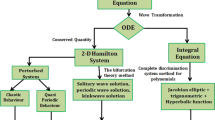Summary
Oscillations in a class of piecewise linear (PL) equations which have been proposed to model biological control systems are considered. The flows in phase space determined by the PL equations can be classified by a directed graph, called a state transition diagram, on anN-cube. Each vertex of theN-cube corresponds to an orthant in phase space and each edge corresponds to an open boundary between neighboring orthants. If the state transition diagram contains a certain configuration called a cyclic attractor, then we prove that for the associated PL equation, all trajectories in the regions of phase space corresponding to the cyclic attractor either (i) approach a unique stable limit cycle attractor, or (ii) approach the origin, in the limitt→∞. An algebraic criterion is given to distinguish the two cases. Equations which can be used to model feedback inhibition are introduced to illustrate the techniques.
Similar content being viewed by others
References
Bellman, R.: Introduction to Matrix Analysis. New York: McGraw-Hill, 1970
Bourgeois, S., Monod, J.: Lac regulatory system. In: Control Processes in Multicellular Organisms (Wolstenholme, G., Knight, J., ed.), London: Churchill, 1970
Friesen, W. O., Poon, M., Stent, G. S.: An oscillatory neuronal circuit generating locomotory rhythm. Proc. Natl. Acad. Sci. (U.S.)73, 3734–3738 (1976).
Gantmacher, F. R.: Applications of the Theory of Matrices, New York: Interscience, 1959
Glass, L.: Combinatorial and topological methods in nonlinear chemical kinetics. J. Chem. Phys.63, 1325–1335 (1975a)
Glass, L.: Classification of biological networks by their qualitative dynamics. J. Theor. Biol.54, 85–107 (1975b)
Glass, L.: Global analysis of nonlinear chemical kinetics. In: Statistical Mechanics, Part B (Berne, B. J., ed.), New York: Plenum, 1977a
Glass, L.: Combinatorial aspects of dynamics in biological systems. In: Statistical Mechanics and Statistical Methods in Theory and Application: A Tribute to Elliot W. Montroll (Landman, U., ed.) New York: Plenum, 1977b
Glass, L., Kauffman, S. A.: The logical analysis of continuous nonlinear biochemical control networks. J. Theor. Biol.39, 103–129 (1973)
Glass, L., Pasternack, J. S.: Prediction of limit cycles in mathematical models of biological oscillations. Bull. Math. Biol. (in press) (1978)
Goodwin, B. C.: Oscillatory behavior in enzymatic control processes. In: Advances in Enzyme Regulation, 3 (Weber, G., ed.), Oxford: Pergamon, 1965
Griffith, J. S.: Mathematics of cellular control processes. J. Theor. Biol.20, 202–216 (1968)
Hastings, S.: On the uniqueness and global asymptotic stability of periodic solutions for a third order system. Rocky Mountain Journal of Mathematics7, 513–538 (1977)
Hastings, S., Tyson, J., Webster, D.: Existence of periodic solutions for negative feedback control systems. J. Diff. Eqs.25, 39–64 (1977)
Hirsch, M. W., Smale, S.: Differential Equations, Dynamical Systems and Linear Algebra. New York: Academic Press, 1974
Hsü, I-D.: The existence of nonlocal, periodic solutions for the Glass-Kauffman model of cellular dynamics. J. Diff. Eqs.25, 39–64 (1977)
Hunding, A.: Limit cycles in enzyme systems with nonlinear negative feedback. Biophys. Struct. Mech.1, 47–54 (1974)
Kauffman, S. A.: Metabolic stability and epigenesis in randomly constructed genetic nets. J. Theor. Biol.22, 437–467 (1969)
Kling, V., Szekeley, G.: Simulation of rhythmic nervous activities, I. Function of networks with cyclic inhibitions. Kybernetik5, 89–103 (1968)
Lee, J. W.: An extremal property of positive operators and its spectral implications. Applic. Anal.1, 359–379 (1972)
Lehninger, A. L.: Biochemistry. New York: Worth Publishers, 1970
Leslie, P. H.: On the use of matrices in certain population mathematics. Biometrika35, 182–212 (1945)
Marsden, J. E.: Basic Complex Analysis. San Francisco: W. H. Freeman, 1973
Marsden, J. E., McCracken, E.: The Hopf Bifurcation, New York, Springer-Verlag, 1977
May, R. M.: Limit cycles in predator-prey communities. Science177, 900–902 (1972)
May, R. M.: Biological populations obeying difference equations: Stable points, stable cycles and chaos. J. Theor. Biol.51, 511–524 (1975)
May, R. M., Leonard, W. J.: Nonlinear aspects of competition between three species. SIAM J. Appl. Math.29, 243–253 (1975)
Monod, J., Jacob, F.: General conclusions: Teleonomic mechanisms in cellular metabolism, growth and differentiation. Cold Spring Harbour Symp. Quant. Biol.25, 389–401 (1961)
Monod, J., Wyman, J., Changeux, J.-P.: On the nature of allosteric transitions. J. Mol. Biol.12, 88–118 (1965)
Othmer, H. G.: The qualitative dynamics of a class of biochemical control circuits. J. Math. Biol.3, 53–78 (1976)
Rössler, O.: In Lecture Notes in Biomathematics. Vol. 4, p. 546–582. New York: Springer-Verlag, 1974
Simon, Z.: Multi-steady-state model for cell differentiation. J. Theor. Biol.8, 258–263 (1965)
Smale, S.: A mathematical model of two cells via Turing's equation. In: Lectures on Mathematics in the Life Sciences (Cowan, J., ed.), Providence: american Mathematical Society, 1974
Sugita, M.: Functional analysis of chemical systemsin vivo using a logical circuit equivalent, II. The idea of a molecular automaton. J. Theor. Biol.4, 179–192 (1963)
Tyson, J. J.: On the existence of oscillatory solutions in negative feedback cellular control processes. J. Math. Biol.1, 311–315 (1975)
Usher, M. B.: Developments in the Leslie matrix model. In: Mathematical Models in Ecology (Jeffers, J. N. R., ed.), p. 29–60. Oxford: Blackwells, 1972
Walter, C.: Oscillations in controlled biochemical systems. Biophys. J.9, 863–872 (1971)
Yagil, G., Yagil, E.: On the relation between effector concentration and the rate of induced enzyme synthesis. Biophys. J.11, 11–27 (1971)
Yagil, G.: Quantitative aspects of protein induction. In: Curr. Top. Cell Reg. 9 (Horecker, B. L., Stadtman, E. R., eds.), New York: Academic Press, 1975
Author information
Authors and Affiliations
Rights and permissions
About this article
Cite this article
Glass, L., Pasternack, J.S. Stable oscillations in mathematical models of biological control systems. J. Math. Biology 6, 207–223 (1978). https://doi.org/10.1007/BF02547797
Received:
Revised:
Issue Date:
DOI: https://doi.org/10.1007/BF02547797




